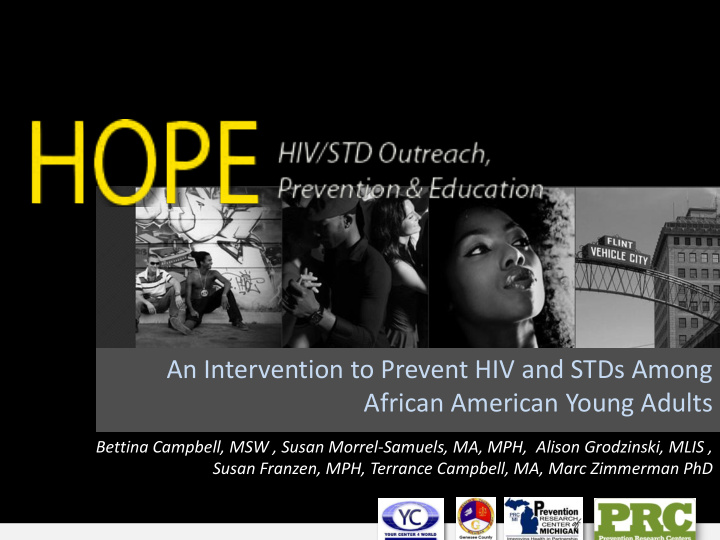



An Intervention to Prevent HIV and STDs Among African American Young Adults Bettina Campbell, MSW , Susan Morrel-Samuels, MA, MPH, Alison Grodzinski, MLIS , Susan Franzen, MPH, Terrance Campbell, MA, Marc Zimmerman PhD
Prevention Research Center of Michigan Safe and Healthy Futures
YYOUR CENTER
RESEARCH QUESTION Purpose Promote healthy sexuality through HOPE parties and HOPE on-line
Conceptual Model Social Network Mediators Network Size Psychosocial Strong & Weak Ties Mediators Network Healthy Sexuality Proximity Knowledge Outcomes & Density Communications Network Perceived with Partners Communications Norms Peer Education+ HOPE Parties & Interactive Social Safer Sex Attitudes Behaviors Website Technologies Peer Education HOPE Parties Self- Sexually Efficacy (only) Only Transmitted Infections
Outcomes Communication with partners HIV/STD Testing Condom use Drug and alcohol use before sex Number of sex partners Population Rates of HIV and other STDs
HOPE Parties Hosts and staff plan party Hosts invite 8-10 friends Educator leads healthy sexuality activities Participants create risk reduction plan
HOPE PARTY ACTIVITIES Introduce team Obtain consent Warm-ups (games, myths, quizzes) Basic HIV/STI presentation Safer sex tools demonstration Role plays Group discussion and interaction Food
STAFFING Comfortable talking about sex Able to work with diverse individuals/groups Familiar with community and culturally aware Knowledgeable about HIV/STI Committed to project Enjoys work – can have fun
RECRUITMENT Clinics STD/Family Planning Community Networks CBOs Churches Events Continual Engagement
FOLLOW-UP • Post-tests at 3, 6, and 12 months Highly mobile population Multiple methods of contact Incentives Persistence
HOPE ON-LINE Build a community Offer peer support Provide expert advice List local resources Exchange information
Goals 1. Make the website engaging 2. Make the features and content relevant 3. Incorporate into their natural digital world
Research Considerations • Privacy and confidentiality • Data collection from participants • Flexibility in design • Evaluation
Challenge #1: Changing Technology
Challenge #2: Internet Access
Challenge #3: Sexual Health Content
ADVISORY GROUP • Former hosts and participants • Facilitated by community outreach worker • Make suggestions for improvements • Promote parties & on-line engagement
Challenges • Shared leadership University constraints Community constraints • Recruitment • Participant Engagement • Momentum
Issues to Consider Need Relevance Representation Capacity Sustainability
Acknowledgements This presentation was supported by the Prevention Research Center of Michigan Cooperative Agreement Number 1-U48-DP- 001901 from the Centers for Disease Control and Prevention. The research reported here does not necessarily represent the official position of the Centers for Disease Control and Prevention.
Contact: Bettina Campbell YOUR Center bettinacampbell@yc4w.org www.yc4w.org Susan Morrel-Samuels Prevention Research Center of Michigan sumosa@umich.edu www.sph.umich.edu/prc/ http://hopegenesee.org
Recommend
More recommend